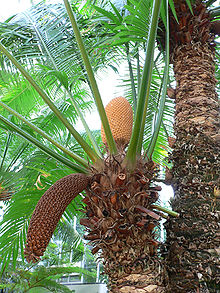Cycad
|
Cycadophyta Temporal range: Early Permian–Recent |
|
|---|---|
 |
|
| Cycas rumphii with old and new male cones. | |
| Scientific classification | |
| Kingdom: | Plantae |
| Division: |
Cycadophyta Bessey 1907: 321. |
| Class: |
Cycadopsida Brongn. |
| Orders | |
|
|
Cycads /ˈsaɪkædz/ are seed plants with a long fossil history that were formerly more abundant and more diverse than they are today. They typically have a stout and woody (ligneous) trunk with a crown of large, hard and stiff, evergreen leaves. They usually have pinnate leaves. The individual plants are either all male or all female (dioecious). Cycads vary in size from having trunks only a few centimeters to several meters tall. They typically grow very slowly and live very long, with some specimens known to be as much as 1,000 years old. Because of their superficial resemblance, they are sometimes mistaken for palms or ferns, but are only distantly related to either.
The living cycads are found across much of the subtropical and tropical parts of the world. The greatest diversity occurs in South and Central America. They are also found in Mexico, the Antilles, southeastern United States, Australia, Melanesia, Micronesia, Japan, China, Southeast Asia, India, Sri Lanka, Madagascar, and southern and tropical Africa, where at least 65 species occur. Some can survive in harsh desert or semi-desert climates (xerophytic), others in wet rain forest conditions, and some in both. Some can grow in sand or even on rock, some in oxygen-poor, swampy, bog-like soils rich in organic material. Some are able to grow in full sun, some in full shade, and some in both. Some are salt tolerant (halophytes).
...
Wikipedia
